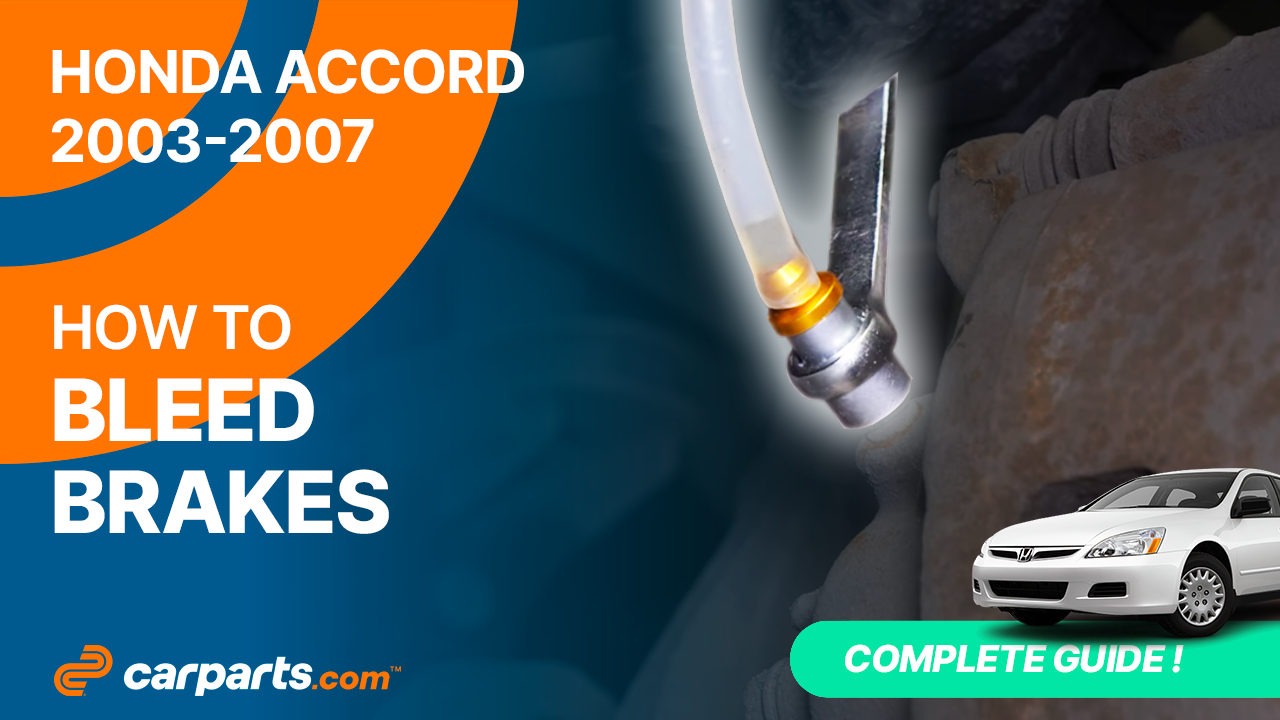
How to bleed the brake fluid system 2003-2007 Honda Accord
To bleed the brake fluid system on your Accord just follow the steps. You will need to open the hood, open the brake fluid reservoir, prepare the rear bleeder as well as carry out a few other steps. You can follow this tutorial of 11 chapters in 50 minutes. Take your 10 mm wrench and your fluid container and let’s get started!
Duration
50 minutes
Number of steps
11
Difficulty out of 5
3
Average savings
$50
Parts You Will Need
Tools You Will Need
Step-by-Step Installation
Chapter 1:
Open the hood
Step 1/1
Turn off your vehicle’s ignition, set the parking brake, pull the hood release handle and open the hood.

Chapter 2:
Open the brake fluid reservoir
Step 1/2
Remove any residual vacuum (or hydraulic pressure) from the brake power booster by applying the brake several times with the engine off.

Chapter 2:
Step 2/2
Open the brake fluid reservoir.

Chapter 3:
Renew the brake fluid
Step 1/3
Using a flat head screwdriver, remove the reservoir filter.


Chapter 3:
Step 2/3
In the case of a complete bleeding of the brake fluid circuit, you must start by emptying the used fluid using a pump.





Chapter 3:
Step 3/3
Put the filter back in place. Then fill the reservoir with new fluid to the maximum level.


Chapter 4:
Informations
Step 1/2
When you bleed the brake fluid circuit on your Honda Accord, there is a bleeding order to follow.On this vehicle, the order is as follows:
– passenger side rear wheel
– driver’s side rear wheel
– passenger side front wheel
– driver’s side front wheel




Chapter 4:
Step 4/2
You will therefore have to successively lift each part of your vehicle, then remove each wheel in order to access the bleeders located on the brake calipers.
















Chapter 5:
Prepare the rear bleeder
Step 1/3
Once the wheel is removed, you have access to the bleeder located on the brake caliper.

Chapter 5:
Step 2/3
Start by removing the stopping plug.

Chapter 5:
Step 3/3
If your caliper is in poor condition, take a wire brush and brush the bleeder clean before applying penetrating oil, to make sure you don’t break the trap if it gets rusty.


Chapter 6:
Bleed
Step 1/3
There are several tools to perform a brake fluid bleed.There are several tools to perform a brake fluid bleed.
A wrench, a plastic tube and a jar may suffice.You can also use brake bleeder wrenches connected to a tube fitted with a non-return system, which prevents air from re-entering the circuit.
Chapter 6:
Step 2/3
Once the bleeder is open, simply pump the brake pedal gently to evacuate the air from the system and replace the old fluid with new.







Chapter 6:
Step 3/3
Once the circuit has been bled, close the bleeder and remove the tool.


Chapter 7:
Clean
Step 1/3
Don’t forget to clean the parts around the bleeder with brake cleaner to remove all traces of brake fluid.

Chapter 7:
Step 2/3
Put the stopping plug back in place.

Chapter 7:
Step 3/3
Clean both sides of the disc with brake cleaner and a cloth, in order to remove the grease and brake fluid deposited during the operation.


Chapter 8:
Bleed other bleeders
Step 1/1
For the front calipers, perform the same operation.

Chapter 9:
Bleed
Step 1/7
You can also use a different technique with more common tools.

Chapter 9:
Step 2/7
Brush the bleeder and spray it with penetrating oil.
Chapter 9:
Step 3/7
Simply put the wrench on the bleeder, then connect the plastic tube to the bleeder and let the end of the tube soak in the reservoir.


Chapter 9:
Step 4/7
Then just ask another person to lightly press the brake pedal.

Chapter 9:
Step 5/7
At this time, open the bleeder to let the brake fluid drain. Then close it again before air rises in the system.



Chapter 9:
Step 6/7
The assistant must then release the brake pedal. Then press again. Then you need to reopen the bleeder, and to close it again before the air rises in the system.





Chapter 9:
Step 7/7
Repeat this operation until there is no more air in the system.




Chapter 10:
Tips
Step 1/3
No matter what tool you use, it is important to regularly add brake fluid to the reservoir to prevent air from entering the master cylinder. It is even advisable to be assisted with this operation to prevent this error.

Chapter 10:
Step 2/3
Once the circuit on your Honda Accord has been bled, close the bleeder and remove the tool. Don’t forget to clean the bleeder with brake cleaner to remove all traces of brake fluid.





Chapter 10:
Step 3/3
Once all four wheels have been purged, fill the reservoir with new fluid to the maximum level.


Chapter 11:
Safety tips
Step 1/5
Once the bleeding is done, check that your brakes are working properly.The brake pedal should feel hard when pumped without being spongy.

Chapter 11:
Step 2/5
Warning: If you have any concern about the effectiveness of your braking system, do not use the vehicle.
Chapter 11:
Step 4/5
On models equipped with ABS, it is possible for air to be trapped in the hydraulic control unit of the anti-lock braking system.
Chapter 11:
Step 5/5
If the brake pedal remains soft after several bleedings or if the BRAKE or ANTI-LOCK indicator remains illuminated, have the vehicle towed to the dealer service center or another approved workshop to have it bled.
Chapter 11:
Step 6/5
Operation complete.
